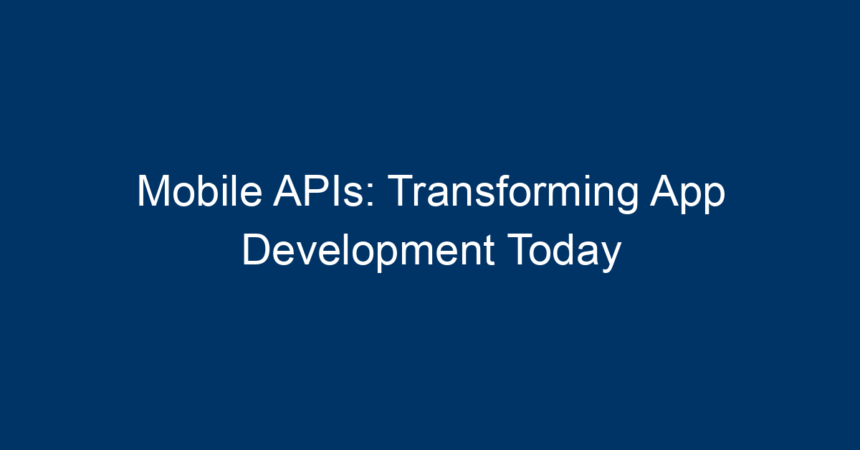In today’s fast-paced digital landscape, app development is more dynamic and transformative than ever before. Mobile APIs (Application Programming Interfaces) are at the forefront of this evolution, providing developers with the tools they need to enhance user experiences, streamline development processes, and integrate third-party services seamlessly. This article dives deep into the role of mobile APIs in app development, discussing their benefits, key types, and best practices for leveraging them effectively.
What Are Mobile APIs?
Mobile APIs serve as intermediaries that allow different software applications to communicate with one another. They are specially designed for mobile platforms, enabling developers to enhance app functionalities without reinventing the wheel. By utilizing mobile APIs, developers can access features and services from third-party platforms, effectively reducing the time and resources required for app development.
Why Mobile APIs Matter
1. Speed Up Development Time
One of the primary advantages of mobile APIs is their ability to accelerate the app development process. By using existing APIs, developers can integrate various functionalities, such as payment processing, geolocation, and social media sharing, without having to build these components from scratch. This not only saves time but also reduces the potential for errors—developers can focus on innovating rather than rebuilding.
2. Enhance Functionality
Mobile APIs provide access to a plethora of features that can significantly enhance app functionality. For instance, by integrating payment gateways through APIs like PayPal or Stripe, developers can implement secure transactions seamlessly. Additionally, APIs for cloud services enable developers to store and manage user data efficiently, ensuring that apps remain responsive and user-friendly.
3. Foster Innovation
With mobile APIs, developers can create innovative applications that combine various services. For example, an app that aggregates news could utilize APIs to pull in articles from different sources while also fetching user location data to offer localized content. This capability encourages creative solutions and fosters a culture of innovation in app development.
4. Improve User Experience
A well-designed app should meet user expectations. Mobile APIs facilitate this by allowing developers to customize experiences based on user behavior and preferences. APIs can enable features like personalized recommendations, instant notifications, and real-time updates, all contributing to a richer user experience.
Key Types of Mobile APIs
Understanding the different types of mobile APIs can help developers choose the right tools for their projects. Here are some of the most notable categories:
1. Open APIs
Also known as external or public APIs, open APIs are accessible to anyone with an internet connection. They are a great resource for developers looking to leverage existing platforms like social media, weather services, or mapping applications. Popular examples include the Twitter API and Google Maps API.
2. Internal APIs
Internal APIs, or private APIs, are designed for use within an organization. They allow different teams or applications within a business to communicate and integrate functionalities seamlessly. For instance, an internal API might connect a company’s web application with its mobile app, ensuring consistent data across platforms.
3. Partner APIs
Partner APIs are shared with specific partners or collaborators, often with restrictions on who can access them. These APIs are typically more secure and contain sensitive information, such as financial data. Businesses often use partner APIs for affiliate programs or co-marketing efforts.
4. Composite APIs
Composite APIs allow developers to access multiple endpoints in a single call, streamlining processes by reducing the number of requests made to the server. This is especially useful for mobile applications that require diverse data sets to function efficiently.
Integrating Mobile APIs Into Your App Development Process
Step 1: Identify Your Needs
Before integrating any mobile API, it’s crucial to identify the specific needs of your app. Consider what functionalities are essential for your application and research available APIs that can meet those requirements.
Step 2: Evaluate API Providers
Not all APIs are created equal. Research and evaluate potential API providers based on criteria like:
- Ease of Use: Look for user-friendly documentation and SDKs.
- Performance: Choose APIs known for reliability and speed.
- Cost: Consider the pricing models of different APIs to ensure they fit your budget.
Step 3: Implement and Test
Once you’ve selected the appropriate API, implement it into your app. Thoroughly test the integration to ensure it communicates correctly and performs as expected. Pay attention to error handling and edge cases to enhance user experience.
Step 4: Monitor and Maintain
After deployment, ongoing monitoring is imperative. Track API performance and analyze user feedback to identify areas for improvement. Regular maintenance ensures that your app continues to function smoothly as APIs evolve.
Best Practices for Using Mobile APIs
Maximizing the potential of mobile APIs requires adherence to certain best practices:
1. Prioritize Security
Security should be a top priority when working with mobile APIs. Use encryption, authentication mechanisms, and secure access tokens to protect sensitive user data.
2. Optimize for Performance
Ensure that API calls are optimized to enhance user experience. Minimize the amount of data transferred and utilize caching strategies when applicable.
3. Keep Documentation Handy
Clear documentation is crucial for effective API integration. Maintain comprehensive references for any APIs used in your application to facilitate troubleshooting and updates down the line.
4. Stay Updated
APIs undergo updates and changes regularly. Subscribe to the release notes or changelogs of the APIs you utilize to keep your applications up to date. Regular updates ensure compatibility and performance.
Real-World Examples of Successful Mobile API Integration
1. Airbnb
Airbnb leverages multiple mobile APIs to enhance its user experience. From payment gateways to real-time availability checks, these integrations enable Airbnb to provide a seamless booking experience.
2. Uber
Uber uses mapping and payment APIs to streamline its ride-hailing service. By integrating Google Maps for navigation and payment gateways for smooth transactions, Uber enhances user satisfaction and operational efficiency.
3. Spotify
Spotify utilizes APIs to integrate social sharing features, allowing users to share their playlists on various social media platforms effortlessly. This API integration enhances user engagement and expands its user base.
Conclusion: The Future is API-Driven
Mobile APIs are undeniably transforming the landscape of app development. They empower developers to build innovative, user-centered applications while reducing development time and cost. By understanding the types of APIs available and following best practices for integration, developers can harness the full potential of mobile APIs, leading to successful applications that meet the demands of today’s tech-savvy users.
Actionable Insights
- Research Mobile APIs: Spend time exploring available mobile APIs to find those that align with your application goals.
- Prioritize Security: Always integrate security measures when using APIs to safeguard user data.
- Monitor Performance: Use analytics tools to track the performance of APIs within your app and adapt as necessary.
By embracing mobile APIs, developers can not only improve the capabilities of their applications but also create unparalleled user experiences, ensuring they stay competitive in the ever-evolving digital landscape.




